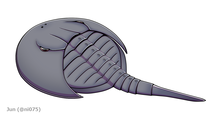Xiphosura
Xiphosura (/zɪfoʊˈsjʊərə/[1]) is an order of arthropods related to arachnids. They are more commonly known as horseshoe crabs (a name applied more specifically to the only extant family, Limulidae). They first appeared in the Hirnantian (Late Ordovician). Currently, there are only four living species. Xiphosura contains one suborder, Xiphosurida, and several stem-genera.
The group has hardly changed in hundreds of millions of years; the modern horseshoe crabs look almost identical to prehistoric genera such as the Jurassic Mesolimulus, and are considered to be living fossils. The most notable difference between ancient and modern forms is that the abdominal segments in present species are fused into a single unit in adults.
Xiphosura were historically placed in the class Merostomata, although this term was intended to encompass also the eurypterids, whence it denoted what is now known to be an unnatural (paraphyletic) group (although this is a grouping recovered in some recent cladistic analyses[2]). Although the name Merostomata is still seen in textbooks, without reference to the Eurypterida, some have urged that this usage should be discouraged.[3] The Merostomata label originally did not include Eurypterida, although they were added in as a better understanding of the extinct group evolved. Now Eurypterida is classified within Sclerophorata together with the arachnids, and therefore, Merostomata is now a synonym of Xiphosura.[4] One recent study places Xiphosura within the Arachnida as the sister group of Ricinulei.[5]
Modern xiphosurans reach up to 60 cm (24 in) in adult length, but the Paleozoic species were often far smaller, some as small as 1 to 3 cm (0.39 to 1.18 in) long.
Their bodies are covered with a tough cuticle, but do not contain any crystalline biominerals,[6] and are divided into an anterior prosoma and a posterior opisthosoma, or abdomen. The upper surface of the prosoma is covered by a semicircular carapace, while the underside bears five pairs of walking legs and a pair of pincer-like chelicerae. The mouth is located on underside of the center of the prosoma, between the bases of the walking legs, and lies behind a lip-like structure called the labrum.[7][8]
Xiphosurans have up to four eyes, located in the carapace. Two compound eyes are on the side of the prosoma, with one or two median ocelli towards the front. The compound eyes are simpler in structure than those of other arthropods, with the individual ommatidia not being arranged in a compact pattern. They can probably detect movement, but are unlikely to be able to form a true image. In front of the ocelli is an additional organ that probably functions as a chemoreceptor.[8]

